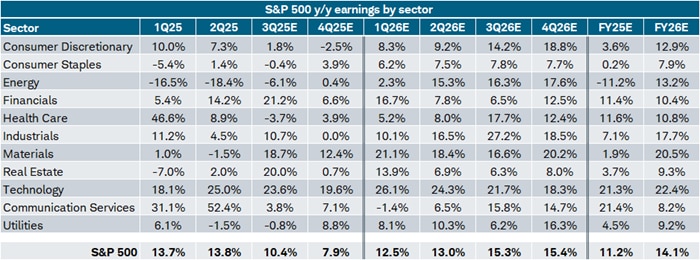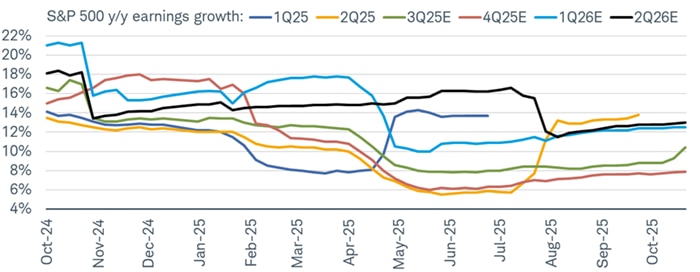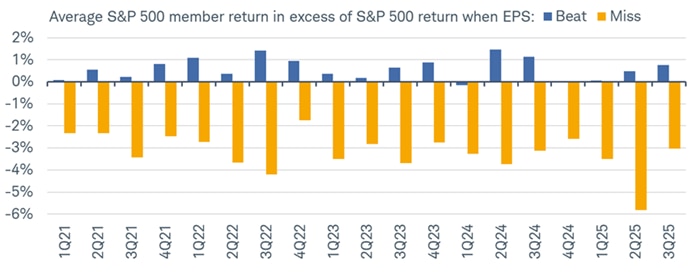Better Days (for Earnings)

Corporate America—or at least as represented by the S&P 500—is delivering a quietly strong earnings season. With about 30% of S&P 500 companies having reported, results have broadly topped expectations. What's being revealed is that profit margins remain resilient, revenues continue to grow, and "beat rates" are running ahead of historical norms. Far from signaling a faltering economy, this quarter's earnings per share (EPS) so far suggest an economic expansion that's only cooling at the edges, not cracking at its core. In fact, perhaps most interesting is that none of the companies having reported so far are directly in the artificial intelligence (AI) space, suggesting that it's not the only economic driver.
Using data from LSEG I/B/E/S, below is the comprehensive table for the S&P 500, including forward EPS estimates into next year. It covers aggregate data/estimates (bottom row), as well as for each of the 11 S&P 500 sectors.

Source: Charles Schwab, LSEG I/B/E/S, as of 10/24/2025.
S&P 500 sectors shown. Sectors are based on the Global Industry Classification Standard (GICS®), an industry analysis framework developed by MSCI and S&P Dow Jones Indices to provide investors with consistent industry definitions. Forecasts contained herein are for illustrative purposes only, may be based upon proprietary research and are developed through analysis of historical public data. Indexes are unmanaged, do not incur management fees, costs and expenses and cannot be invested in directly. Past performance does not guarantee future results.
The S&P 500's third quarter "blended" growth rate, which blends existing reports with estimates for remaining reports, is running at more than 10%, down from the pace of growth in the first half, but better than where estimates were at the start of reporting season. So far, the beat rate is 87%, which compares to the 30-year average of 67% and a prior four quarter average of 77%. In aggregate, S&P 500 companies have reported earnings 8% above estimates, which compares to the 30-year average of 4% and a prior four quarter average of 7%.
Most sectors are running at above-average beat rates, notwithstanding negative expected EPS growth for the Energy, Health Care, Utilities and Consumer Staples sectors. Perhaps no surprise, but the Tech sector's estimated growth sits atop the leaderboard—not just for the third quarter, but every quarter through next year's first half.
Defining earnings "hooks"
Per the chart below, EPS estimates for third-quarter (green) growth have been upwardly revised—not just since earnings season began, but since this past summer. Estimates for the fourth quarter (red) have also been trending higher since then. This is in stark contrast to the first half of the year (navy and yellow), during which estimates only hooked higher once earnings reports were already underway. One thing of note in this visual: the primary reason why 2026's first- (turquoise) and second- (black) quarter EPS growth rates hooked down this year was due to much better-than-expected first and second quarter 2025 growth rates (the base effects meant that next year's year-over-year growth were set to be lower).
Earnings "hooks"

Source: Charles Schwab, LSEG I/B/E/S, as of 10/24/2025.
Forecasts contained herein are for illustrative purposes only, may be based upon proprietary research and are developed through analysis of historical public data. Indexes are unmanaged, do not incur management fees, costs and expenses and cannot be invested in directly. Past performance does not guarantee future results.
Two narratives stand out as to earnings' resilience. First, margins are sturdier than feared with the blended net profit margin near 13% vs. its five-year average of 12%. Assuming no significant diminution of margins, it will mark the sixth consecutive quarter north of the five-year average. That durability—despite tariff instability and higher input costs—is pivotal for sustaining double-digit forward earnings growth.
Second, sector specifics matter. Semiconductors remain the single largest lift inside the Tech sector. Financials are reporting broad double-digit EPS growth across all five of the sector's industries. Even Utilities have gotten into the "beats" game, flattered by outsized contributions from AI/data center-related stocks. At the other end of the spectrum, in Health Care, downgrades and weaker EPS prints at several large constituents have pulled the sector's earnings lower.
Beats rewarded, misses not
From a performance perspective, earnings season has been a solid underpinning for the market. As shown in the chart below, for companies beating EPS estimates, their average gain—relative to the S&P 500—that day is 0.76%. For those missing estimates, the average relative loss is -3.03%. Both readings are muted relative to history, but the trend over the past year has been one in which the beats have been rewarded at an increasingly better rate.
Beats increasingly rewarded

Source: Charles Schwab, Bloomberg, as of 10/24/2025.
Member performance in excess of S&P 500 based on gain or loss following day in which earnings are reported. Indexes are unmanaged, do not incur management fees, costs and expenses and cannot be invested in directly. Past performance does not guarantee future results.
Not coincidentally, that has occurred as revisions have strengthened. Shown below is the U.S. Earnings Revisions Index from Citi; and for most of the second half of this year, it has been in positive territory. After taking a sharp, recessionary-like move lower earlier this year—when EPS estimates were in free fall to account for "Liberation Day" tariffs—the index has had an equally forceful rebound. Worth noting, however, is that this is not a leading indicator for market performance. The index was near all-time highs by late 2021, yet the S&P 500 experienced a bear market in 2022.
Earnings revisions remain healthy

Source: Charles Schwab, Bloomberg, as of 10/17/2025.
The Citi U.S. Earnings Revisions Index is calculated as the ratio of analysts' earnings per share revisions to listed companies tracking equity analyst revisions upgrades (positive) vs. downgrades (negative). Indexes are unmanaged, do not incur management fees, costs and expenses and cannot be invested in directly. Past performance is no guarantee of future results.
In sum
Third-quarter earnings season is shaping up as another testament to U.S. corporate resilience. Tech's leadership continues to reflect multi-year AI and electrification investment waves. Industry-level growth suggests capital spending related to compute, data centers, and grid/power remains a tailwind even as broader manufacturing is mixed. Consumer-facing bellwethers and cyclical pockets are surprising positively, consistent with steady nominal demand. The drags from Energy and Health Care are not macro-systemic, while overall margins confirm late-cycle stability, not contraction. Above-trend margins and decent top-line growth argue that pricing power and cost discipline remain intact enough to offset wage and input cost pressures.
The S&P 500's double-digit expected EPS growth and unusually high beat rates underscore a still-healthy demand backdrop and disciplined cost control. To date, earnings reports are painting a picture of an economy that's bending a little under government and monetary policy uncertainty, but far from breaking. If forthcoming mega-cap and AI hyper-scalers reports don't upend the pattern, the earnings floor for 2025 looks firmer than the consensus feared a couple of months ago.

